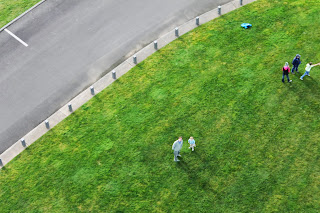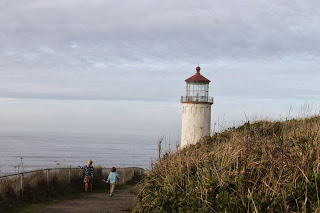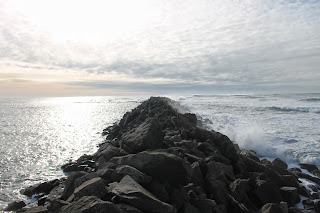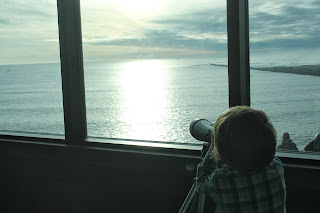I found these three doing dishes again when I got back
from my run....
Abundance.....yes!
Back to Astoria to walk up the historic column and see
really far down! We were thankful for a clear day!
There is a airplane flying down in the middle of the
picture. We found out you can buy a glider for a dollar
and then have fun flying off the top after you climb 164 steps!
Hi Bobo and Dada way down there!
We heard that Cape Disappointment was not that far
when we were visiting the Astoria Column so we
decided to go for it. Andrew and I were both so curious
about these treacherous waters where river meets ocean
and we wanted to check it out.
We stopped at one scenic overlook and read that after 4 shipwrecks
in one year they decided to build a lighthouse. As they were
carrying supplies to build the lighthouse along with the four others,
that ship sank two miles off shore....so it took a few more years to get
the lighthouses up and providing a beacon of light.
"Before there were lighthouses on the Peninsula, ships bound for Portland and Astoria navigated their way through the high waves and shifting sandbars, focusing on fluttering white flags and notched trees along the shoreline by day and flickering signal fires by night. These methods were crude at best and, despite heroic efforts, the sea offshore of the Long Beach Peninsula became known as ‘The Graveyard of the Pacific’."
On to North head Lighthouse.
"In 1788, while in search of the Columbia River, English Captain John Meares missed the passage over the river bar and named the nearby headland Cape Disappointment for his failure in finding the river. In 1792, American Captain Robert Gray successfully crossed the river bar and named the river “Columbia” after his ship, the Columbia Rediviva. Only a few years later, in 1805, the Lewis and Clark Expedition arrived at Cape Disappointment."
North Head Lighthouse,
Completed in 1898, it guides ships from the North.
Next we took a walk on the North Jetty, to again get
close to the area where waves meet river.
The jetty was formed in part to help ships gain safe passage.
(Dev and Bobo)
hand in hand.... they walk a lot
The jetty started to narrow and the rocks became more
difficult to navigate.
Ocean on the right, Columbia River on the left..
we found out later it was a calm day.
Cape Disappointment Lighthouse on the right.
North Jetty taken from the Interpretive Center, there
is also a South Jetty on the other side.
A short film describing the journey Lewis and Clark made
to find the Pacific.
Cape Disappointment Lighthouse
"Cape Disappointment Lighthouse is the oldest
operating lighthouse (1856) on the West Coast."
Both lighthouses are fully functioning and they
have been run and operated by the Coast Guard since 1939.
We received a treat to meet a coast guard in his post at the
watch tower right at the lighthouse. We found out that they
still perform about 300 rescues a year. Again we discussed what
makes the waters so treacherous, I felt all day I was trying
to piece together both with my eyes and what I was reading
what made these waters so dangerous. He said the largest
ships stay inside the buoy lines and that helps them not hit
the sand. The other ships often get into trouble due to the
currents changing, strong currents, and large ocean waves, often those
doing recreational boating.
This Coast Guard station provides boat training, due to such
"great waters" to receive training.
We also met a photographer who has been living with
the Coast Guard crew since March and will be filming
for a new show, "Coast Guard Pacific Coast" which will
be airing on the Weather channel in the new year, it will be
just like "Coast Guard Alaska."
The life saving station was started in 1871, it is between
those trees.
We promised Bobo time in the music room in the Hostel,
so he had some music time.
They loved the bunk beds! Us not so much as the wildness
would start after our long day, it was a whole new toy!





























































No comments:
Post a Comment